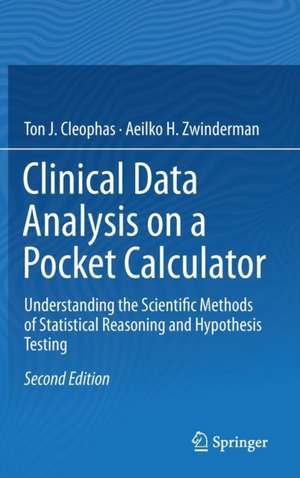Clinical Data Analysis on a Pocket Calculator: Understanding the Scientific Methods of Statistical Reasoning and Hypothesis Testing
Autor Ton J. Cleophas, Aeilko H. Zwindermanen Limba Engleză Hardback – 29 ian 2016
| Toate formatele și edițiile | Preț | Express |
|---|---|---|
| Paperback (1) | 645.05 lei 6-8 săpt. | |
| Springer International Publishing – 30 mar 2018 | 645.05 lei 6-8 săpt. | |
| Hardback (1) | 652.06 lei 6-8 săpt. | |
| Springer International Publishing – 29 ian 2016 | 652.06 lei 6-8 săpt. |
Preț: 652.06 lei
Preț vechi: 686.37 lei
-5% Nou
Puncte Express: 978
Preț estimativ în valută:
124.85€ • 130.01$ • 103.59£
124.85€ • 130.01$ • 103.59£
Carte tipărită la comandă
Livrare economică 13-27 februarie
Preluare comenzi: 021 569.72.76
Specificații
ISBN-13: 9783319271033
ISBN-10: 3319271032
Pagini: 334
Ilustrații: XXIII, 334 p. 65 illus., 24 illus. in color.
Dimensiuni: 155 x 235 x 21 mm
Greutate: 0.68 kg
Ediția:2nd ed. 2016
Editura: Springer International Publishing
Colecția Springer
Locul publicării:Cham, Switzerland
ISBN-10: 3319271032
Pagini: 334
Ilustrații: XXIII, 334 p. 65 illus., 24 illus. in color.
Dimensiuni: 155 x 235 x 21 mm
Greutate: 0.68 kg
Ediția:2nd ed. 2016
Editura: Springer International Publishing
Colecția Springer
Locul publicării:Cham, Switzerland
Cuprins
Preface.-I Continuous Outcome Data.- Data Spread, Standard Deviations.- Data Summaries:Histograms, Wide and Narrow Gaussian Curves.- Null-Hypothesis Testing withGraphs.- Null-Hypothesis Testing with the T-table.- One-Sample Continuous Data (One-SampleT-Test, One-Sample Wilcoxon.- Paired Continuous Data (Paired T-Test, Two-SampleWilcoxon Signed Rank Test).- Unpaired Continuous Data (Unpaired T-Test,Mann-Whitney).- Linear Regression (Regression Coefficients, CorrelationCoefficients, and their StandardErrors).- Kendall-Tau Regressionfor Ordinal Data.- Paired Continuous Data, Analysis with Help of CorrelationCoefficients.- Power Equations.- Sample Size Calculations.- ConfidenceIntervals.- Equivalence Testing instead of Null-Hypothesis Testing.- NoninferiorityTesting instead of Null-Hypothesis Testing.- Superiority Testing instead ofNull-Hypothesis Testing.- Missing Data Imputation.- Bonferroni Adjustments.- Unpaired Analysis of Variance(ANOVA).- Paired Analysis of Variance (ANOVA).-VariabilityAnalysis for One or Two Samples.- 22 Variability Analysis for Three or More Samples.-Confounding.- Propensity Score and Propensity Score Matching for MultipleConfounders.- Interaction.- Accuracy and Reliability Assessments.- Robust Testsfor Imperfect Data.- Non-linear Modeling on a Pocket Calculator.- FuzzyModeling for Imprecise and Incomplete Data.-Bhattacharya Modeling for Unmasking Hidden Gaussian Curves.- Item ResponseModeling instead of Classical Linear Analysis of Questionnaires.- Meta-Analysis.- Goodness of Fit Tests for Identifying Nonnormal Data.-Non-Parametric Tests for Three or More Samples (Friedman and Kruskal-Wallis).- IIBinary Outcome Data.-Data Spread: StandardDeviation, One Sample Z- Test, One Sample Binomial Test.- Z-Tests.- Phi Testsfor Nominal Data.- 38 Chi-Square Tests.-Fisher Exact Tests Convenient for Small Samples.- Confounding.- Interaction.- Chi-squareTests for Large Cross-Tabs.- Logarithmic Transformations, a Great Help to StatisticalAnalyses .- Odds Ratios, a Short-Cut for AnalyzingCross-Tabs.- Log odds, the Basis of Logistic Regression.- Log Likelihood Ratio Testsfor the Best Precision.- Hierarchical Loglinear Models for Higher Order Cross-Tabs.- McNemar Tests for Paired Cross-Tabs.-McNemar Odds Ratios.- Power Equations.- Sample Size Calculations.- AccuracyAssessments.- Reliability Assessments.- Unmasking Fudged Data.- Markov Modelingfor Predictions outside the Range of Observations.- Binary Partitioning with CART (Classificationand Regression Tree) Methods.- Meta-Analysis.- Physicians' Daily Life and theScientific Method.- Incident Analysis and the Scientific Method.- Cochran Testsfor Large Paired Cross-Tabs.-Index.
Notă biografică
The authorsare well-qualified in their field. Professor Zwinderman is past-president ofthe International Society of Biostatistics (2012-2015), and Professor Cleophasis past-president of the American College of Angiology(2000-2002). From their expertise they should be able to make adequateselections of modern methods for clinical data analysis for the benefit ofphysicians, students, and investigators. The authors have been working andpublishing together for 17 years, and their research can be characterized as acontinued effort to demonstrate that clinical data analysis is not mathematicsbut rather a discipline at the interface of biology and mathematics.
The authors as professors and teachers instatistics at universities in The Netherlands and France for the most part oftheir lives, are convinced that the scientific method of statistical reasoningand hypothesis testing is little used by physicians and other health workers,and they hope that the current productionwill help them find the appropriateways for answering their scientific questions.
Threetextbooks complementary to the current production and written by the sameauthors are Statistics applied to clinical studies 5th edition, 2012, Machinelearning in medicine a complete overview, 2015, SPSS for starters and 2ndlevelers, 2015, all of them edited by Springer Heidelberg Germany.
The authors as professors and teachers instatistics at universities in The Netherlands and France for the most part oftheir lives, are convinced that the scientific method of statistical reasoningand hypothesis testing is little used by physicians and other health workers,and they hope that the current productionwill help them find the appropriateways for answering their scientific questions.
Threetextbooks complementary to the current production and written by the sameauthors are Statistics applied to clinical studies 5th edition, 2012, Machinelearning in medicine a complete overview, 2015, SPSS for starters and 2ndlevelers, 2015, all of them edited by Springer Heidelberg Germany.
Textul de pe ultima copertă
Ineveryone's life the day comes that medical and health care has the highestpriority. It is unbelievable, that a field, so important, uses the scientificmethod so little. The current book is helpful for implementation of thescientific method in the daily life of medical and health care workers. Fromreaders' comments to the first editions of this work, the authors came torealize that statistical software programs is experienced by professionals inthe field as black box programs producing lots of p-values, but little answersto scientific questions, and many readers had not been happy with thatsituation. The pocket calculator analyses appeared to be, particularly,appreciated, because they enabled readers for the first time to understand thescientific methods of statistical reasoning and hypothesis testing. So much so,that it started something like a new dimension in their professional world.
We should add a number of statistical methods can be performed more easily on a pocketcalculator, than using a software program. Also, there are some specific advantages of thepocket calculator method. You better understand what you are doing. The pocketcalculator works faster, because far less steps have to be taken, averages canbe used. With statistical software all individual data have to be included separately,a time-consuming activity in case of large data files. Some analyticalmethods, for example, power calculations and required sample size calculationsare difficult on a statistical software program, and easy on a pocketcalculator.
The reason for a rewrite was to giveupdated and upgraded versions of the forty chapters from the first editions,including the valuable comments of readers. Like in the textbook complementaryto the current work, entitled "SPSS for Starters and 2nd Levelers"(Springer Heidelberg 2015, from the same authors), an improved structure of thechapters was produced, including background, main purpose, scientific question,schematic overview of data files, and reference sections. In addition, for theanalysis of more complex data twenty novel chapters were written. We showedthat, also here, a pocket calculator can be very helpful.
For the readers' convenience the chaptershave been reclassified according to the most basic difference in datacharacteristics: continuous outcome data (34 chapters), binary outcome data (26chapters). Both hypothesized and real data examples are used to explain thesixty pocket calculator methods described. The arithmetic is of a no-more-thanhigh-school level.
The reason for a rewrite was to giveupdated and upgraded versions of the forty chapters from the first editions,including the valuable comments of readers. Like in the textbook complementaryto the current work, entitled "SPSS for Starters and 2nd Levelers"(Springer Heidelberg 2015, from the same authors), an improved structure of thechapters was produced, including background, main purpose, scientific question,schematic overview of data files, and reference sections. In addition, for theanalysis of more complex data twenty novel chapters were written. We showedthat, also here, a pocket calculator can be very helpful.
For the readers' convenience the chaptershave been reclassified according to the most basic difference in datacharacteristics: continuous outcome data (34 chapters), binary outcome data (26chapters). Both hypothesized and real data examples are used to explain thesixty pocket calculator methods described. The arithmetic is of a no-more-thanhigh-school level.
Caracteristici
The medical and health care uses the scientific method little, the book addresses how to daily use it Statistical software programs are experienced as black boxes to non mathematiciens All specific advantages of pocket calculators are summarized












